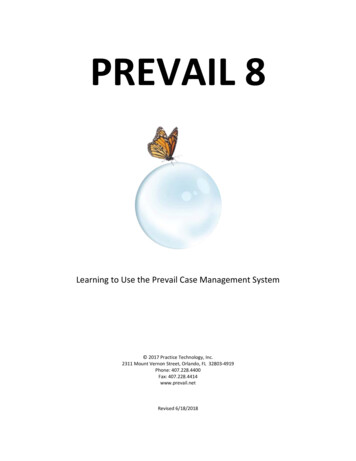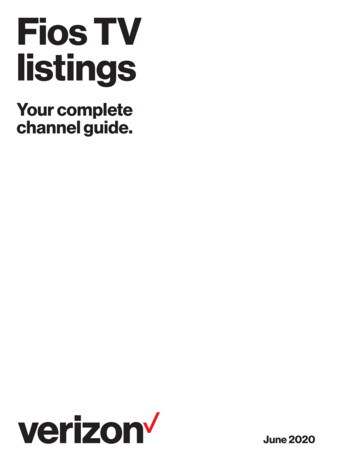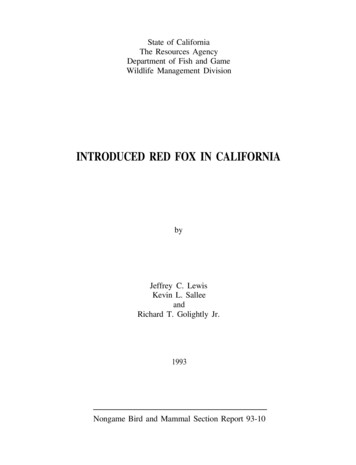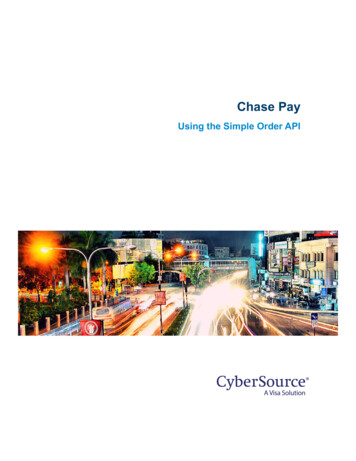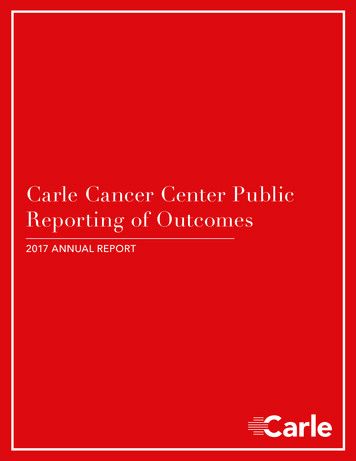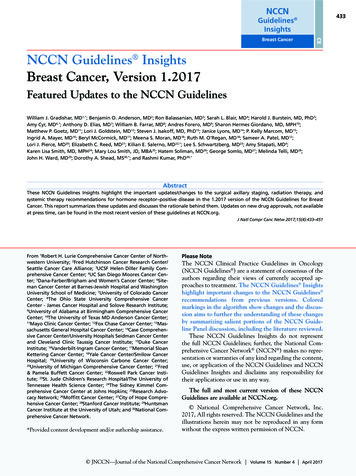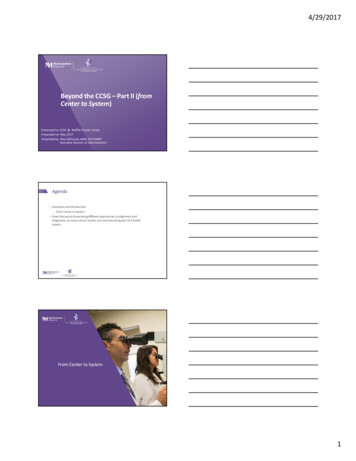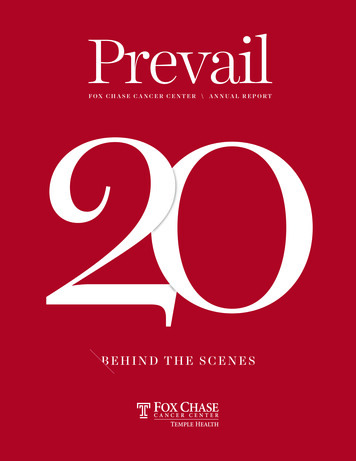
Transcription
PrevailF OX C H A S E C A N C E R C E N T E R \ A N N UA L R E P O R TBEHIND THE SCENES
BEHIND THE SCENES
“OUR WORK IS DRIVE N BY OUR COM PA SS I ONFOR OT HE RS A ND A S E NS E O F DE DICAT IONTO T HE PAT IENTS A ND FA M IL IE S W H O TURNTO US FOR CA NCE R CA RE . I T S H OWS INAL L T HAT WE D O, O F T E N TA KING PL AC EQUIE T LY BE H IND T H E S CE NE S.”— RICHARD I. FISHER, MD
\\\ \ \P R E S I D E N T ’S L E T T E RLITTLE THINGS, LARGE IMPACTThe people of Fox Chase CancerCenter have long embodied a spiritof curiosity and innovation, achievement and progress. Our work isdriven by our compassion for othersand a sense of dedication to thepatients and families who turn to usfor cancer care. It shows in all that wedo, often taking place quietly behindthe scenes.As we embark on a new era—one inwhich we integrate more fully as anentity of Temple University HealthSystem—we reflect on the idea oflittle things and the relationship theyhave with our broader world.This is a pivotal time in manyregards. There are many issues andproblems that surround us: theCOVID-19 pandemic, racial injustice, political division, and economicconcerns. Amidst this backdrop, wecontinue our pursuit of advancingcancer research and treatment.We are welcoming new and deepercollaborations as we renew our partnership with Temple. Still, we holdclose our values of respect, service,and quality. To move forward now is achallenge that presents itself as bothexciting and overwhelming.Despite this challenge, there is apath to be forged. Whether in theclinical realm or the research lab,through our administrative officesand our hallways, or in our relation-ships with donors, colleagues, andfriends, we have so often shaped ourfuture by focusing on little things thathave large impact.In any endeavor, and particularly inmedicine, to delve deeper is to explorethe details. To experience the nuancesof our connections and collaborations.To accomplish all that our potentialholds because we take care to recognize things that may not be obviousto everyone, to address things thatonly some bother to pursue, and tolearn from these observations andinteractions for the betterment of ourpatients and each other.Taken in total, our experiencesinform who we are as individuals andas an institution. These lessons areevident in how we approach our workand the people we serve. All of thelittle things we do and study and remember have a purpose. They illuminate our opportunities, advance ourmission, and propel us to a greatertime to come.As you read about the progress andaccomplishments of the last year atFox Chase, of the many selfless actsof our staff during these challengingtimes, I invite you to think abouthow little things in your own life canhave the potential to effect change inour larger world. Each of us has thisresponsibility. The question we mustask ourselves is this: do I accept?Richard I. Fisher, MDPresident and CEO at Fox Chase4FOX CHASE CANCE R C E N T E R \ P REVA I L \ AN N UAL RE P O RT 2020
I N S T I T U T I O NA L
“I’M VERY HUM BL E D T O BE H ONO RE DWI T H T H IS AWA RD IN M E M O RY O FJAMIE L IEB ERM A N A ND T H E IM P O RTA NTST RUG GL E S H E FOUGH T FO R.”— R ICHARD J. BLEICHER, MD, FACS
Richard J. Bleicher, MD, FACS, was awarded the2020 Jamie Brooke Lieberman RemembranceAward from Susan G. Komen Philadelphia.
\\\ \ \INST I TUT IONALFACULTY TEAM UP TODEVELOP COVID-19 TESTAs COVID-19 began to spread acrossthe country, Fox Chase Cancer Centerclinical and administrative departments teamed up to begin developingin-house COVID-19 testing, whichbegan on April 9.“What became clear to us very quickly was that it was going to be more thanjust a lab effort. It really took piecesfrom all over the institution,” saidDonald Baldwin, PhD, associate professor in the Department of Pathology.Baldwin took on some of the technicalaspects of getting COVID-19 testing offthe ground, while Mariusz Wasik, MD,procured resources and institutionalsupport as the chair of pathology.The main overall project was ledby Judy Bachman, MSN, RN, CNAA,chief operating officer. ChristineBloom, MHA, RDMS, RT, director ofradiation oncology, and Barbara Ebersole, BFA, MA, CCC-SLP, assistantresearch professor in the Division ofHead & Neck Surgery, were co-leads.Marie Riehl, RN, clinical managerof the outpatient department, set upthe testing. Numerous staff memberscontributed to the effort as well.“We did all this with very littlereduction in our normal oncologyWHEN TESTING BEGAN ONAPRIL 9, FOX CHASE TESTED8 PEOPLE ;AT THE HEIGHT OFTHE PANDEMIC, MORE THAN90 PEOPLEA DAY WERE BEING TESTED.10testing, so our lab was faced withlaunching COVID-19 service in addition to the usual demand of genomicsand molecular biology tests for cancerpatients,” said Baldwin. “Whoever wecalled on was willing to help howeverthey could, so it’s been a real pleasureto pull up an entire team to develop abrand new test in record time.”STAFFERS PITCH IN TOPROCESS COVID TESTSAfter Fox Chase researchers developeda test for detecting COVID-19, dozensof other staffers, lab techs and nursesamong them, pitched in to see the testing process through to the end.“It started with a canopy, staff incoats and using umbrellas on a rainyday, with eight tests done on the firstday. It grew into two tents and morethan 90 tests per day,” said Anne Loser,a medical technologist who was involved in several steps of the process.She worked closely with Raquel Dennis, clinical lab supervisor, and QuynhLam, lab manager for the Molecular Diagnostics Laboratory. Lam developedFOX CH ASE CANC E R C E N T E R \ P REVA I L \ AN NUAL RE P O RT 2020the workflow for sample receiving andtracking, quality control and assuranceprotocols, and training and schedulingof techs and data coordinators.As they continued working, theprocess became more efficient. Testing volume tripled since they began,and new equipment allowed them toprocess 96 samples at once. In addition, they used to manually enter testresults, but software automated thatpart of the process.“This was Fox Chase at its finest, itwas a total group effort,” Loser said.“No request was too small. If we metan obstacle, someone found a way toovercome it.”EVEN MASKED, CHAPLAINCONVEYS COMPASSIONAs a staff chaplain at Fox Chase CancerCenter, one of the main tools at thedisposal of Barbara Klimowicz areher words. In this time of COVID-19,even though a mask covers her face,patients, their loved ones, and staff canstill hear her voice. And they can seethe steadfast support, love, compas-
Henry Chi Hang Fung, MD, FACP, FRCPE, is chairof the Department of Bone Marrow Transplantand Cellular Therapies at Fox Chase.
Namrata “Neena” Vijayvergia, MD, wasnamed to The Pennsylvania MedicalSociety’s Top Physicians Under 40 list.
sion, and hope in her eyes.Although the pandemic preventsfamily from being with patients atbedside, or in infusion and radiationareas, Klimowicz steps in to lendsupport wherever and whenever lovedones can’t. Staff are also included inher rounds. She provides “Hope Huddles” throughout the center to provideemotional and spiritual support asneeded during these difficult times.“I travel around the world every dayas people take me with them on theirjourneys of life,” Klimowicz said.STAFF MEMBERS TRACKDOWN RESPIRATORSIn mid-March, as it became clearthat COVID-19 could reach pandemiclevels, feared shortages of medicalsupplies had not yet become an issueat Fox Chase Cancer Center. But thatdidn’t stop employees from preparingfor possible shortages with longershifts and increased efforts to obtainnecessary equipment.Two such staff members are TraceyHunter, supervisor of respiratorycare, and Paul Maher, a respiratorytherapist. The two made numerouscalls to obtain more ventilators forpatients. Despite a national shortageof ventilators due to the emergingpandemic, Hunter and Maher wereeventually able to obtain additionalventilators.“When we were short staffed, peoplewere volunteering, staying longer, anddoing whatever was necessary to meetthe needs of the patient,” said Hunter.that offered at other cancer centers,a characteristic that has becomeknown as “Fox Chaseness.” Even inuncertain times, Fox Chase employees continued to provide a uniquelycaring environment for patients.One shining example of this isLucille Williams, reception supervisor in the Department of RadiationOncology. Williams noticed a patientwas still waiting for a ride two hoursafter his appointment had ended.She became concerned and calledthe patient’s daughter, only to findout she had been in a car accidentand was running late.Williams told the patient what hadhappened. After learning that he hadnot eaten all day, she took him to thecafeteria to buy him lunch and kepthim company.STAFF IN DIAGNOSTIC IMAGINGHAVE A MEDIAN OF WELL OVER20 YEARSOF SERVICE TO FOX CHASE.WORKING OVERTIME TOKEEP EVERYONE SAFEFox Chase relies on the work ofenvironmental services (EVS) to keepthe center clean and sterile, and theirhelp was even more critical duringthe COVID-19 pandemic. EVS staffworked tirelessly to meet the needs ofpatients and staff, and helped ensurethe hospital’s safety with increasedcleaning measures.EMBODYING‘FOX CHASENESS’Fox Chase Cancer Center prides itselfon care and service that goes aboveA NNUA L RE P O RT 2020 \ PREVAIL \ F OX CH ASE CA NC ER C ENTER13
\\\ \ \INST I TUT IONALJonathan Wright, EVS director,said he was never more proud ofhis staff than when they continuedto step up to the plate. “The EVSmanagement team has been extraordinary,” he said.EVS staff, many of whom areindividuals over 60 at higher riskof contracting COVID-19, cancelledpreviously scheduled time off to cometo work every day to improve thehospital’s safety, Wright said.They also put patients at ease, saidKathy Rich, supervisor of housekeeping. “The thing about Fox Chaseis that EVS staff is close with thepatients. It’s pretty impressive.”SERVICE TO PATIENTS,SERVICE TO THECOMMUNITYCaralyn Briscella, BSN, RN, OCN,has been an infusion room nurse atFox Chase for 8 years. When she’s notserving her patients, she’s working toserve the larger community.One of the infusion room’s longterm patients is a nurse at FriendsHospital. She told Briscella abouthow patients are often transferredto Friends in a hospital gown or withjust the clothes on their back, whichis especially a problem in the winter.“I knew I had to help. I reachedout to my coworkers and othersFOX CHASE CANCER CENTER–BUCKINGHAM MARKED ITSTH10ANNIVERSARY.14in ambulatory care and started aclothing drive,” Briscella said. It was“very successful,” with about 30 bagsof clothing collected in a few months.Although temporarily put on hold dueto the COVID-19 pandemic, the driveis scheduled to start back up.MAINTAINING SERVICE TOPATIENTS AND CAREGIVERSDave Miller, a maintenance mechanic, has worked at Fox Chase for 20years and has gone out of his way forpatients and their families a numberof times. But his biggest accomplishment in that area may be helping apatient’s family by taking apart a sofa.A family called maintenance at Temple University Health System, asking ifthey could buy a sofa from a Fox Chasewaiting room because they believed afamily member had lost a wedding ringin it during an appointment.A man was with his wife, who hadcome in for surgery, but she didn’t knowshe couldn’t have any jewelry with her.So she gave the ring to her husband,who put it in his pants pocket. It fell outas he was waiting for her on the sofa.But in the end, his wife didn’t haveher surgery because she was found tohave an elevated heart rate during herpreoperative screening. After trying toFOX CH ASE CANC E R C E N T E R \ P REVA I L \ AN NUAL RE P O RT 2020find the ring on their own, they had togo home, a three-hour drive to the LakeWallenpaupac area of the Poconos.Miller happened to be there whenthe call came in to Fox Chase andvolunteered to try to find the ring. “Ithought, ‘Hey, let’s take a look. Maybe Ican find it.’” He took the couch down tothe maintenance area and after a halfhour, he was able to retrieve the ring.THE IMAGE OF DEDICATIONLong before the COVID-19 pandemicerupted, radiology technologists inthe Department of Diagnostic Imaging were on the front lines providingX-rays, Cat Scans, or other formsof imaging that patients required.And when the pandemic blew up,they continued doing what they hadalways done. “We are one of the firstones to come in contact with patientson a daily basis,” said Christine Dooley, a diagnostic radiology supervisor.Joan Keiper, administrative directorof diagnostic imaging, said the groupis highly dedicated and experienced,with a median of well over 20 yearsof service to Fox Chase. “They areprofessional and have jumped to thecall when needed in rough times. Beit a snow storm or pandemic, they arealways there and ready to lend a hand.”
Kathy Rich (left) and Jonathan Wright(right) worked hard to keep the hospitalclean during the COVID-19 pandemic.
Reception supervisor Lucille Williamswent out of her way to help a patientand even bought him lunch.
A DEDICATED GROUP OF401VOLUNTEERS DONATEDBLEICHER RECEIVESBREAST CANCER AWARDRichard J. Bleicher, MD, FACS, a professor in the Department of SurgicalOncology at Fox Chase, was awardedthe 2020 Jamie Brooke LiebermanRemembrance Award from Susan G.Komen Philadelphia for his work inthe breast cancer community.The award’s namesake, JamieBrooke Lieberman, lost her battlewith inflammatory breast cancerin 2012 at the age of 35. She foughtfor understanding and awareness ofher disease and was active in raisingfunds for research and communityoutreach, early detection, and treatment programs.“Although I never got to meet Jamie, I’m very humbled to be honoredwith this award in memory of JamieLieberman and the important struggle she fought for,” Bleicher said.BONE MARROWTRANSPLANT PROGRAMBECOMES A DEPARTMENTfor International Blood & MarrowTransplant Research, of the 180 transplant centers in the United States,only 12 adult and five pediatric centerswere rated as performing above expectations in 2019. Fox Chase was theonly adult center in the tristate areaand one of only two in Pennsylvania toachieve this distinction.In addition to serving as department chair, Fung, a professor ofmedical oncology, has also served aschief of the Section of HematologicMalignancies and has been recognized as a top doctor three years in arow by Philadelphia magazine.TWO NAMED ‘TOPPHYSICIANS UNDER 40’IN PENNSYLVANIATwo Fox Chase Cancer Center doctors were honored by The Pennsylvania Medical Society (PAMED)by being named to their list of thisyear’s Top Physicians Under 40. Thetwo were Sanjay S. Reddy, MD, FACS,69,583HOURS OF SERVICE.associate professor in the Department of Surgical Oncology, andNamrata “Neena” Vijayvergia, MD,assistant chief of gastrointestinalmedical oncology in the Departmentof Hematology/Oncology. Reddyspecializes in pancreatic cancer andneuroendocrine tumors, and Vijayvergia specializes in neuroendocrinetumors and colorectal cancer.Honorees were nominated by colleagues and selected by a committeeof PAMED members. To appear on thelist, physicians must practice in Pennsylvania and be under the age of 40 onDecember 31, 2020. The 45 physicianson the 2020 list represent 19 different medical specialties. According toPAMED, this select group has demonstrated a significant amount of successearly in their medical careers.The Fox Chase-Temple UniversityHospital Bone Marrow Transplant (BMT) Program is now thenewest department at Fox Chase.The Department of Bone MarrowTransplant and Cellular Therapiesis chaired by Henry Chi Hang Fung,MD, FACP, FRCPE, who was directorof the BMT Program and is also vicechair of the Department of Hematology/Oncology.“With the emerging developmentof cellular therapy and the importance of its role in oncology, we feltit warranted a separate department,”said Richard I. Fisher, MD, presidentand CEO of Fox Chase.In a review performed by the CenterA NNUA L RE P O RT 2020 \ PREVAIL \ F OX CH ASE CA NC ER C ENTER17
\\\ \ \INST I TUT IONALFOX CHASE OUTPERFORMSPEERS, ACCORDING TOSURVEYSFox Chase consistently outperformspeer institutions in patient satisfactionsurveys, according to Press Ganey data,the most recent of which was releasedfor the period of October throughDecember 2019. Overall scores andpercentile rankings for the center areup across most surveys.Press Ganey measures performanceagainst Fox Chase’s peers, comparingthe center’s performance to otherFOX CHASE REGISTERED119,836OUTPATIENT VISITS AND6,738NEW PATIENTS.18National Cancer Institute-designatedcancer centers, to Magnet hospitals,and to American Hospital AssociationRegion 2 hospitals, which cover NewJersey, New York, and Pennsylvania.These highly competitive groupsinclude many institutions thatregularly score higher than peers inthe general Press Ganey database,making it particularly impressive tooutperform them.NURSING RESIDENCYPROGRAM EARNSACCREDITATIONFox Chase Cancer Center has announced that its Nurse ResidencyProgram achieved Practice Transition Accreditation from the American Nurses Credentialing Center(ANCC). They were awarded Accreditation with Distinction, the highestrecognition awarded.“This accreditation validates ourprogram for being evidence-based,current, and relative to nursingFOX CHASE CANC E R C E N T E R \ P R EVA I L \ AN NUAL RE P O RT 2020practice,” said Deborah Baldassarre,MSN, RN, OCN, NPD-BC, NursingResidency Program Coordinator. “Itwas a great experience for all of ushere, to look at our program, evaluateit, and make it better.”The ANCC Practice Transition Accreditation Program validates hospital residency or fellowship programsthat transition registered nurses andadvanced practice registered nursesinto new practice settings that meetrigorous, evidence-based standardsfor quality and excellence.Nurses in accredited transitionprograms such as Fox Chase’s NurseResidency Program experience curricula that promote the acquisitionof knowledge, skills, and professionalbehaviors necessary to deliver safe,high-quality care.EMPLOYEE CANCERSCREENING INITIATIVELAUNCHESIn October 2019, Fox Chase kickedoff its Employee Cancer ScreeningInitiative. The program focuses onproviding education and screeningfor a variety of cancers, includingbreast, lung, colorectal, and headand neck cancer, to all eligible staffmembers.“While cancer education andscreening are mainstays of ourcommunity-based efforts, we alsorecognize the importance of focusing our attention right here withinour institution,” said Richard I.Fisher, MD, president and CEO ofFox Chase. “As we provide cancerprevention, early detection, andtreatment to our patients, it isequally important that we maintaingood health and engage in preventive care ourselves.”
Staff chaplain Barbara Klimowicz beganholding “Hope Huddles” to boost moraleduring the COVID-19 pandemic.A NN UA L R E P ORT 2 0 2 0F OX C H A S E C A NC E R C E N TE R19
CLINICAL
“ T HE EXACTVU SYST E M NO T ONLY A L L OWST HE UROL OGIST TO EVA LUAT E FO R NEW L E SIONSOF CONCE RN, B UT A LS O T RACKS PREVIOUSLYOB SE RVE D L E S IONS OVE R T IM E S O W E CANB ET T ER GAUGE IF T H E CA NCE R IS CH A NGING.”— ANDRES F. CORREA , MD
Andres F. Correa, MD, has spearheadedthe use of a new imaging technologyfor the diagnosis of prostate cancer.
\\\ \ \CLINICALNEW MICRO-ULTRASOUNDIMAGING TECHNOLOGYFox Chase has purchased a newmicro-ultrasound system that physicians say could change the way prostate cancer is diagnosed and treated.The ExactVu Micro-UltrasoundSystem builds upon the standardtransrectal ultrasound, typically usedfor prostate procedures, by featuringa 300% improvement in resolution,allowing physicians to identifyprostate cancer tumors with accuracycomparable to MRI.The ExactVu system is an exciting addition to Fox Chase and thePhiladelphia region, as it providesone of the most cutting-edge imagingtechnologies available for the diagnosis and treatment of prostate cancer,said Andres F. Correa, MD, assistantprofessor in the Department ofSurgical Oncology.“The ExactVu system not only allows the urologist to evaluate for new24lesions of concern, but also trackspreviously observed lesions over timeso we can better gauge if the cancer ischanging,” Correa said. He added thatRosalia Viterbo, MD, FACS, an associate professor in the Department ofSurgical Oncology, was “instrumental” in securing the funds to purchasethe technology, which was raisedfrom patients and other donors.MINT REFRESHES CANCERIMAGING AND ASSESSMENTDetermining how to treat patientsdiagnosed with cancer can be challenging, but there are other hurdlesto overcome once treatment begins.One is assessing how well patients areprogressing by tracking the size oftumors and other responses.To do this more effectively, FoxChase recently launched the Diagnostic Imaging Research ProtocolLab, a virtual lab designed to provideaccurate and consistent treatmentFOX CH ASE CANC E R C E N T E R \ P R EVA I L \ AN N UAL RE P O RT 2020THE MOST COMMON TYPESOF CANCER AMONG PATIENTSTREATED AT FOX CHASE WEREPROSTATE(18 % ),BREAST(15 % ),LUNG(10 % ),AND GYNECOLOGICAL(9 % ).response assessments for clinicaltrial patients. The assessments areconducted by radiologists who haveexpertise in cancer imaging andtreatment response criteria.The lab features MINT Lesion Software from MINT Medical, said JordanAnaokar, MD, the director of the laband an associate professor in theDepartment of Diagnostic Imaging.The software helps provide immediatefeedback on how patients are responding to treatment, with graphicalrepresentation of tumor response.After radiologists identify tumorsto be tracked on the baseline study,the software automatically findsthem on the follow-up studies. Theradiologists can then confirm thatthe tumor is the same one that wasmeasured initially and provide a newmeasurement, features that streamline the review process and minimize
A NNUA L RE P O RT 2020 \ PREVAIL \ F OX CH ASE CA NC ER C ENTER25
\\\ \ \CLINICALpher J. Manley, MD, an assistant professor and director of InterventionalPulmonology.Manley has started a prospectiveclinical trial studying the safety andfeasibility of incorporating needle-based confocal laser microscopywith the Monarch Platform. Thestudy is in partnership with the University of Amsterdam and supported by Mauna Kea Technology andJohnson and Johnson. The platformwas purchased through funds raisedfrom In Vino Vita, Fox Chase’s annual signature fundraising event.MULTICENTER PANCREATICCYST TRIAL LAUNCHESerrors. “That accuracy could makeFox Chase more attractive for clinicaltrials,” Anaokar said.Margaret von Mehren, MD, chiefof the division of sarcoma medicaloncology, championed the purchaseof the system, which was funded bymoney raised by In Vino Vita, FoxChase’s signature fundraising event.PATIENTS UNDERWENTA VARIETY OF TREATMENTS,INCLUDING SURGERY(4,477),RADIATION THERAPY(28,002),AND CHEMOTHERAPYINFUSIONS(62,883).26FURTHER EVIDENCE ANDKUDOS FOR ROBOTICBRONCHOSCOPYIn the first published study sincethe market release of robot-assistedbronchoscopy, researchers at FoxChase found the technology to besafe, feasible, and reliable for achieving diagnoses for lung cancer. Thediagnostic technology is used to viewthe inside of the lungs and obtaintissue samples for biopsy.Fox Chase was one of the firstcancer centers in the nation to obtainthis technology, marketed as theMonarch Platform. In addition, FoxChase was honored with the LifeSciences Pennsylvania 2019 PatientImpact Award for pioneering use ofthe system.“Compared with traditionalbronchoscopy, this new technologyprovides improved reach and dexterity, affording us the ability to biopsysmall nodules safely,” said Christo-FOX CHASE CANC E R C E N T E R \ P REVA I L \ AN N UAL RE P O RT 2020An eight-year, multicenter study ofpancreatic cysts funded by the National Cancer Institute launched in spring2020. Cysts are commonly identifiedlesions that can evolve into pancreaticcancer. Fox Chase is the headquartersfor the project, although the trial isopen to participation at hundreds ofsites around the country.The main focus of the new trial isto compare the clinical effectivenessof two surveillance strategies usedto track pancreatic cysts. Researchers will also look at the costs of cystsurveillance, the impact on patientsof long-term follow-up, and attempt toidentify novel molecular markers andradiology findings that may predictthe behavior of these cysts, said DavidS. Weinberg, MD, MSc, chair of theDepartment of Medicine at Fox Chaseand principal investigator for the trial.“Nobody’s under any illusionthat either surveillance strategy ascurrently written is good enough.They are the best we have for now, butwe are looking for something better,”Weinberg said.
Jordan Anaokar, MD, directs a lab that usesdiagnostic imaging to provide consistentassessments for clinical trial patients.
RESEARCH
“ WE USE MOUSE M O DE LS T O UNDE RSTA ND H OWSOME OVARIAN CA NCE RS INI T IAT E IN T H EFAL L OPIAN TUBE A ND S PRE A D TO T H E OVA RYAND TO L EA RN H OW TO INH IBI T T H EGROWT H O F T H E S E TUM O RS.”— DENISE CONNOLLY, PHD
Denise Connolly, PhD, received the SandyRollman Ovarian Cancer Foundation’sTeal Trailblazer Award.
\\\ \ \RESEARCHINFLUENZA FINDINGSCOULD HAVE KEY IMPACTON CANCER THERAPIESA scientist at Fox Chase clarified afundamental host defense mechanism that detects the presence ofinfluenza virus and rapidly destroysinfected cells.The new findings have excitingimplications for a variety of fields,including cancer immunotherapy,said Siddharth Balachandran, PhD,lead author of the study and professorin the Blood Cell Development andFunction program.In previous research, Balachandran and other researchers had identified a protein called ZBP1 that isessential for sensing the presence ofinfluenza virus in lung cells. But theydid not know how ZBP1 was beingactivated. “In other words, what wasZBP1 ‘seeing’ that told it the cell wasinfected? Now, we know the answer,”Balachandran said.32It turns out that ZBP1 “sees”Z-RNA, a new form of RNA producedby influenza virus. “Folks have beenlooking for Z-RNA for decades. Thisparticular structure of RNA is what iscalled a pathogen-associated molecular pattern, and discovering a newsuch pattern is a major milestone. Italso has significant implications forcancer immunotherapies, becausedrugs that activate ZBP1 have strongpotential for combinatorial use withimmune checkpoint agents such asnivolumab,” Balachandran said.FOX CHASE RESEARCHERSPROVIDE NEW INSIGHTSINTO BRCA-MUTATEDCANCERSIn two studies conducted at FoxChase, researchers have uncoveredprocesses that may contribute to thedevelopment of BRCA-mutated cancers and have also shed light on theresponse and resistance of cancers toFOX CH ASE CANC E R C E N T E R \ P REVA I L \ AN N UAL RE P O RT 2020RESEARCHERS HAD644SCIENTIFIC ARTICLESPUBLISHED.certain chemotherapies.Mutations in the BRCA1 andBRCA2 tumor suppressor genesare the strongest known geneticrisk factor for breast and epithelialovarian cancer. In addition, inheritedmutations in BRCA genes are now understood to contribute to other cancertypes, including colon and prostate.Although BRCA genes increase cancer risk, tumors with such mutationsare particularly sensitive to someforms of cancer therapy.“The findings have implications forcancer therapy because drugs knownas PARP inhibitors successfully treatBRCA1-mutant breast and ovariancancers,” Neil Johnson, an associateprofessor in the Molecular Therapeutics Program at Fox Chase, said ofone of the studies. “Our work suggestsdifferent mutations may disable DNArepair by different mechanisms andcould impact response and resistanceto PARP inhibitors.”In the other study, Johnson andcolleagues identified the proteinRNF168 as a key component ofthe BRCA DNA repair pathway. Inindividuals without mutated BRCA1and BRCA2 mutations, the proteinsproduced by these genes play a majorrole in repair of DNA, protecting itfrom mutations. This function is lostwhen the BRCA genes are mutated.Johnson and colleagues showedthat when BRCA1 is absent, excessive
RNF168 expression increases DNAdamage when cells replicate and contributes to the high level of mutationseen in BRCA1-mutated cancers. Hislaboratory is seeking to understandhow cells regulate levels of RNF168expression, what additional functionsRNF168 performs, and how this pathway can be targeted for the development of new cancer drugs.CONNOLLY WINS AWARDFOR OVARIAN CANCERRESEARCHDenise Connolly, PhD, an associateprofessor in the Molecular Therapeutics Program at Fox Chase, receivedthe Sandy Rollman Ovarian CancerFoundation’s Teal Trailblazer Award.Connolly is currently researching asubtype of ovarian cancer — highgrade serous carcinoma — in mousemodels to understand why not allovarian cancer arises in the ovaries.“Some ovarian cancer arisesoutside of the ovary and travels to theovary,” she said. “When the patientis diagnosed, it looks like the ovariesare the main site of involvement. Weuse mouse models to understand howsome ovarian cancers initiate in thefallopian tube and spread to the ovaryand to learn how to inhibit the growthof these tumors.”FOX CHASE RESEARCHERSHONORED AS AMERICANCANCER SOCIETY GRANTEESIn November 2019, three Fox Chaseresearchers were honored as newgrantees by the American CancerSociety at its Philadelphia office.Stephen M. Sykes, PhD, assistantprofessor in the Blood Cell Development and Function Program,received a Research Scholar Grantfor 792,000 to support research onthe elucidation and exploitation ofmolecular pathways that supportleukemia.John Krais, PhD, a postdoctoralresearcher in the lab of Neil Johnson,PhD, received a grant for 107,500 toimprove understanding of DNA repair pathways in BRCA1-mutant cells.His research specifically focuses on aprotein called RNF168 that recruitsmultiple proteins involved in theDNA damage response.Jaye Gardiner, PhD, a postdoctoralresearcher in the lab of Edna Cukierman, PhD, r
10 fox chase cancer center \ prevail \ annual report 2020 \\\\\ institutional when testing began on april 9, fox chase tested 8 people; at the height of the pandemic, more than 90 people a day were being tested. g44653_fccc ar 20 body p1-43 final.indd 10 11/13/20 3:48 pm

